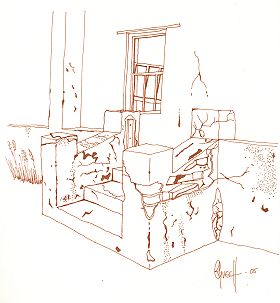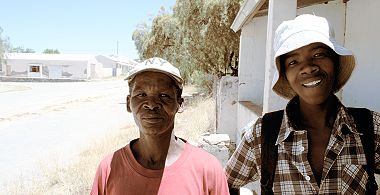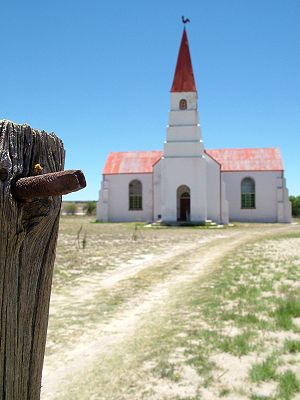
Prologue
| Day 1 |
Day 2
| Day 3 | Day 4
| Day 5 | Epilogue |
About Us | Home
Campbell
| Griekwastad | Niekerkshoop
| Prieska | Vanwyksvlei
| Carnarvon

Campbell
Day 2: 17 December 2005 SATURDAY
 Once
again we almost missed another town because we almost didnít realize we
were in Campbell. We never saw a sign to indicate to us that we had
reached it. We simply came upon a stop street, and when we looked around
to figure out which way to go, we couldnít. The sign we actually did see
all indicated that Campbell was still coming, and at the stop street it
showed that we had to go back the way we came, so we were quite
confused. Trees and shrubs hid the small number of houses and shacks
that would have indicated to us that we were actually in a small town.
But nevertheless, we saw glimpses of these houses and shacks when we
drove around to explore the area.
Once
again we almost missed another town because we almost didnít realize we
were in Campbell. We never saw a sign to indicate to us that we had
reached it. We simply came upon a stop street, and when we looked around
to figure out which way to go, we couldnít. The sign we actually did see
all indicated that Campbell was still coming, and at the stop street it
showed that we had to go back the way we came, so we were quite
confused. Trees and shrubs hid the small number of houses and shacks
that would have indicated to us that we were actually in a small town.
But nevertheless, we saw glimpses of these houses and shacks when we
drove around to explore the area.
The first house we actually came
upon was so striking, we both excitedly jumped out the car to take
photographs. Plaster had fallen off some parts of it, and a small gate
at the front stood awkwardly to one side, which would still allow
someone to pass through though we strongly doubt anyone still lives
there. Itís not so badly ruined that one wouldnít be able to make
anything out of it, because the gutters where still there and the wooden
window frames might be skew from someone carelessly pushing it up, but
it was clearly a place that had been lived through. I wondered what
stories it would have told if it where able to talk.
 Itís
only when I was hunching down to get a different angle of this
dilapidated house that I heard music come from a small blue shack hidden
behind a tree besides the house. As soon as the music reached my ears,
the local from the blue shack came walking up to his gate right next to
the house and greeted us with a smile that had a few teeth missing! A
few locals then came walking down the street and our neighbour greeted
them excitedly and we heard them laughing and talking about us. Just as
they reached us Etienne asked them whether they would mind having their
picture taken. They where very shy, and I wondered whether anyone else
had ever taken a photograph of them before. The younger boy would most
probably have had his photograph taken at his school, if he actually did
attend school on the other hand. When Etienne showed them the photograph
they laughed in excitement and at themselves. The older local kept
rubbing his head and smiled, while the younger boy laughed and teased
the old man. As they walked away we heard their happy bantering all the
way down the street.
Itís
only when I was hunching down to get a different angle of this
dilapidated house that I heard music come from a small blue shack hidden
behind a tree besides the house. As soon as the music reached my ears,
the local from the blue shack came walking up to his gate right next to
the house and greeted us with a smile that had a few teeth missing! A
few locals then came walking down the street and our neighbour greeted
them excitedly and we heard them laughing and talking about us. Just as
they reached us Etienne asked them whether they would mind having their
picture taken. They where very shy, and I wondered whether anyone else
had ever taken a photograph of them before. The younger boy would most
probably have had his photograph taken at his school, if he actually did
attend school on the other hand. When Etienne showed them the photograph
they laughed in excitement and at themselves. The older local kept
rubbing his head and smiled, while the younger boy laughed and teased
the old man. As they walked away we heard their happy bantering all the
way down the street.
 We
discovered that the whole town was quite neglected. But a sense of
lively spirit was clearly still there. A small soccer field was right in
the centre of town. Its goalposts consisting of tree trunks, some
slightly skewer than the next, and the ground was just plain gravel. I
shuddered to think what it must have felt like to collide at speed with
that type of surface, but I was sure that they somehow managed to use
the field. The rest of the town consisted of old run-down Karoo houses
and a fair number of shacks to my surprise. Thin dogs roamed between the
shacks, and horses grazed on whatever grass they could find, but I never
once caught a glimpse of doom or depression. Itís as if they had made
the most of what they had.
We
discovered that the whole town was quite neglected. But a sense of
lively spirit was clearly still there. A small soccer field was right in
the centre of town. Its goalposts consisting of tree trunks, some
slightly skewer than the next, and the ground was just plain gravel. I
shuddered to think what it must have felt like to collide at speed with
that type of surface, but I was sure that they somehow managed to use
the field. The rest of the town consisted of old run-down Karoo houses
and a fair number of shacks to my surprise. Thin dogs roamed between the
shacks, and horses grazed on whatever grass they could find, but I never
once caught a glimpse of doom or depression. Itís as if they had made
the most of what they had.
A small boy was walking amongst rocks in deep thought, swaying his
stick, with his dog ever slowly trailing behind him. When he caught
sight of us he became very shy but still walked to have a closer look at
us. His ketty was hanging over his neck and he leaned against a fence
pole. When we asked his permission for a photograph, he nodded, but his
little brother must have been nearby, because just as the first photo
was taken, he came strolling up to us in curiosity, playing with a twig
in his hands. Their mother pushed her head out the door and looked at us
in concern, but when we waved at her, all we saw was a big broad smile.
It might be a small neglected little town, but the spirit of that place
was absolutely stunning and it does rub off on oneself.
The distance from Campbell to Griekwastad was approximately 48km.
* * * * *
A short history:
The first church north from the
Orange river was built in 1831 by John Bartlett from the London
Missionary Society in Campbell. It was restored and declared a national
monument.
The townís name came from a visit from John Campbell, director of the
LSG, in 1813 to the Griekwa community, which was then known as
Knovelvallei. After Campbell he visited again in 1820, he then decided
to establish a full missionary station, and Bartlett, the second
incumbent (holder of office), was appointed in 1825. He paid for his
church with money he earned as a (grofsmid) in Cape town.
Additional Pictures:
![]()
Forgotten
Towns of the Karoo
Web Design © CoZania.co.za
March 2006




